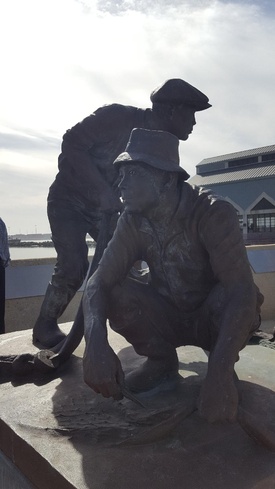Travel uproots daily routines for new places and new discoveries. But, somehow, my own discoveries in my own travels have often given me deeper roots—especially in my evolving Japanese American identity.
* * * * *
Hiroshima, Japan. Still half asleep, a few of us high schoolers crept out of the hotel and down to the water to watch the first rays of light over the bay—a mandatory, I thought, when visiting the land of the rising sun. This exchange trip across Japan was my first time seeing the “motherland,” and I eagerly took in everything from ornate temples to whimsical vending machines.
The trip also gave me an opportunity to visit relatives, including a few in Hiroshima. But although our family shares a common origin there, I have come to realize how much our stories have since followed different paths. The differences emerge in daily commonplaces like language: When my grandmother took her own first trip to Japan just a few years ago, she amused a taxi driver with her Japanese, which would have been more at home a century ago. Her vocabulary had frozen in time with her own mother’s tongue, but the language had moved on without its emigrants.
The difference in our family’s World War II experiences is more dramatic. For the American side, World War II meant internment in the dust storms of Poston, Arizona. For the Hiroshima side, it meant the devastation of atomic weapons and the designation of hibakusha—survivors of the bomb. It benefits no one to compare their sufferings for the purpose of competition. But it highlights just how divergent our family tree has grown from the same root.
* * * * *
Gatehouse of Fleet, Scotland. A world away from Japan, I looked out over a sparkling bay from my perch atop a ruined castle, an interlude in a trip across southwest Scotland. On its face, the memory has nothing to do with identity. But I remember it clearly as the moment I decided to return to the U.S. after finishing graduate school in London.
It was the first time I’d lived outside the States for an extended period of time—and the first time that I’d realized just how American I really was. I learned about the accent I never knew I had, as British classmates imitated words and phrases. One of my closest friends and I called each other roommates, but we could never agree on just how to pronounce “room.”
But even as my experiences in London have helped me realize aspects of my American identity, I can’t help but notice similarities, some of which spring from those Japanese roots. My “roommate” is Japanese British, and on my last trip back, we exchanged omiyage in the middle of Leicester Square and shared our affinity for the recent Nobel Prize lecture by Kazuo Ishiguro, himself a Japanese British writer. We may come from different countries and cultures now, but somehow, our roots still unite the different branches of the Nikkei tree.
* * * * *
Terminal Island, California. Fish Harbor seemed calm, even as preparations for the morning’s monument celebration bustled behind me. I watched the water, standing next to the plinth where two fishermen gazed in opposite directions across a lost home—my own family’s furusato before Executive Order 9066 forced them to the mainland and eventually to Poston.
Crossing the Vincent Thomas Bridge over shipping barges and stacked containers brings me to my family’s roots in America. Like many other Terminal Islanders before the war, my great-grandfather was a fisherman, and my great-grandmother worked in the canneries. My family often returns to those roots, at least in memory. Fifteen years ago, shortly before her passing at age 105, my great-grandmother was one of two issei women to cut the ribbon for the Terminal Island monument. Just this month, I silently greeted my grandfather’s childhood image in the Japanese American National Museum’s photo of the Terminal Island Baptist Church congregation.
From those roots, internment spread my family across the country—from California to Oklahoma and Minnesota to New Jersey and Florida. It’s my family tree—and it’s the Nikkei family tree in microcosm. From Japanese roots, the diaspora circles the world in unique and beautiful branches.
© 2018 Ariel Okamoto




